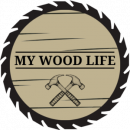It’s happened to all of us – we’re in the middle of a woodturning project and suddenly our beautiful dark wood turns white! What do you do? Don’t panic – there are a few ways to fix the problem. In this blog post, we’ll discuss what causes wood to turn white and how to fix it. We’ll also provide some tips on how to prevent your wood from turning white in the first place.
What Does It Mean That Wood Turns To Be White?
Before we get into how to fix the problem, let’s first discuss what causes wood to turn white. The most common cause is a reaction between the tannins in the wood and the iron in your tools. When these two substances come into contact with each other, they create a chemical reaction that bleaches the wood. This reaction is more likely to occur with certain types of wood, such as oak and walnut.
Why Does My Wood Turn To Be White?
Reaction Between Wood And Iron
There are a few reasons why your wood may turn white. The most common reason, as we mentioned above, is a reaction between the tannins in the wood and the iron in your tools. This reaction is more likely to occur with certain types of wood, such as oak and walnut.
Exposure To Sunlight
Another reason why wood may turn white is if it’s exposed to too much sunlight. UV rays can bleach the wood, causing it to turn white. (Keep It Away From Heated Places)
Rusty Tools
If you’re using tools that are rusty, they may also be causing your wood to turn white. Rusty tools can transfer iron oxide onto the wood, which will then react with the tannins and cause the wood to bleach.
Damp Wood
Another common cause of wood bleaching is dampness. If the wood is too damp, it will absorb moisture from the air and this can cause it to turn white.
Excessive Sanding
If you sand your wood too much, it can also cause it to turn white. Sanding removes the top layer of the wood, which can expose the lighter layers underneath. This is more likely to occur with softer woods, such as pine.
Using The Wrong Type Of Wood
If you’re using the wrong type of wood for your project, it may also cause the wood to turn white. For example, using a softwood such as pine for an outdoor project is more likely to result in the wood turning white because it’s not as durable as a hardwood.
How To Prevent My Wood Turn To Be White?
There are a few things you can do to prevent your wood from turning white.
Clean Your Tools If Needed
If you’re using a lathe, the problem is most likely caused by your chisels. When you’re working with wood, it’s inevitable that some shavings will end up on your chisels. Over time, these shavings will rust and cause the tannins in the wood to react. The best way to prevent this from happening is to regularly clean your chisels with a wire brush. You should also oil them after every use to prevent rusting.
Prevent Sun Damage
Another common cause of bleached wood is sunlight. If you’re working on a project that will be exposed to sunlight, it’s important to take precautions to prevent bleaching. One way to do this is to apply a UV-resistant finish to your project. You can also try working in a shady area or covering your project with a cloth when you’re not using it.
Use The Right Type Of Wood
If you’re using the wrong type of wood for your project, it may also cause the wood to turn white. For example, using a softwood such as pine for an outdoor project is more likely to result in the wood turning white because it’s not as durable as a hardwood.
What Should I Do If My Wood Turn To Be White?
If your wood has already turned white, there are a few things you can do to try and fix the problem.
Use A Wood Stain
One way to try and fix bleached wood is to use a wood stain. This will darken the wood and help to mask the discoloration. However, it’s important to test the stain on a small area of the wood first to make sure it doesn’t further damage the wood.
Use A Wood Dye
Another option is to use a wood dye. This will penetrate the wood and change its color. Unlike a stain, a dye won’t just sit on the surface of the wood. However, it’s important to test the dye on a small area of the wood first to make sure it doesn’t further damage the wood.
Repair The Finish
If the finish on your project is damaged, this can also cause the wood to turn white. In this case, you’ll need to remove the old finish and apply a new one. This is a more difficult process and it’s best to consult a professional if you’re not sure how to do it.
Prevent Future Damage
Once you’ve fixed the problem, there are a few things you can do to prevent it from happening again in the future.
Clean Your Tools Regularly
If you’re using tools that are rusty, they may also be causing your wood to turn white. The best way to prevent this is to clean your tools regularly. You should also oil them after every use to prevent rusting.
Apply A UV-Resistant Finish
If you’re working on a project that will be exposed to sunlight, it’s important to take precautions to prevent bleaching. One way to do this is to apply a UV-resistant finish to your project. You can also try working in a shady area or covering your project with a cloth when you’re not using it.
How To Fix Blushing Wood?
If your wood is blushing, it means that the finish hasn’t had enough time to cure. The best way to fix this problem is to let the finish cure for a longer period of time. You can also try sanding the area with a fine-grit sandpaper to remove the blush.
How To Fix Heated Wood Discoloration?
When wood is heated, the moisture in the wood fibers expands. This can cause the wood to change color, usually to a darker shade. The good news is that this discoloration is usually only superficial and can be fixed fairly easily.
There are a few things you can do to fix heated wood discoloration. One option is to simply sand the area until the discoloration is gone. This will also help to smooth out any roughness caused by the heat.
Another option is to use a wood stain or sealer. This will help to protect the wood from future discoloration and will also give it a new, fresh look.
How To Remove Blushing From Wood Furniture?
If your wood furniture is blushing, the best thing you can do is to remove the old finish and apply a new one. This is a more difficult process and it’s best to consult a professional if you’re not sure how to do it.
You can also try sanding the area with a fine-grit sandpaper to remove the blush. This will also help to smooth out any roughness caused by the heat.
How To Fix Wood Discoloration From Softwood?
If your wood discoloration is from softwood, the best thing you can do is to use a wood stain or sealer. This will help to protect the wood from future discoloration and will also give it a new, fresh look.
You can also try sanding the area with a fine-grit sandpaper to remove the discoloration. This will also help to smooth out any roughness caused by the heat.
How To Fix Wood Discoloration From Hardwood?
If your wood discoloration is from hardwood, the best thing you can do is to use a wood dye. This will penetrate the wood and change its color. Unlike a stain, a dye won’t just sit on the surface of the wood.
It’s important to test the dye on a small area of the wood first to make sure it doesn’t further damage the wood.
You might also try sanding the blemish to remove the discoloration. This will also help to smooth out any roughness caused by the heat.
How To Fix Wood Discoloration From Sunlight?
If your wood discoloration is from sunlight, the best thing you can do is to apply a UV-resistant finish to your project. You can also try working in a shady area or covering your project with a cloth when you’re not using it.
How To Fix Wood Discoloration From Water?
If your wood discoloration is from water, the best thing you can do is to let the wood dry completely and then sand it with a fine-grit sandpaper. This will remove the discoloration and also help to smooth out any roughness caused by the water.
You can also try using a wood sealer or stain to protect the wood from future discoloration.
How To Fix Wood Discoloration From Mold?
If your wood discoloration is from mold, the best thing you can do is to remove the mold and then sand the area with a fine-grit sandpaper. This will remove discoloration and smoothen out any roughness caused by the mold.
You may also use a wood sealer or stain to keep the wood from fading over time.
How To Fix Wood Discoloration From Smoke?
If your wood discoloration is from smoke, the best thing you can do is to use a wood stain or sealer. This will help to protect the wood from future discoloration and will also give it a new, fresh look.
You can also try sanding the area with a fine-grit sandpaper to remove the discoloration. It will also assist to smooth out any scuffing caused by the smoke.
Can Wood Discoloration Stay Permanent?
Yes, the wood discoloration can stay permanent if it’s not fixed right away. We recommend To Read The Above Tips To know how you can fix it. Wood discoloration can also come back if the wood is not properly protected from future damage.
Conclusion
Wood discoloration is a common problem, but it’s one that can be easily fixed with the right tools and techniques. With a little bit of effort, you can make your wood look like new again. We recommend following the tips above to fix your wood discoloration and avoid it in the future.









